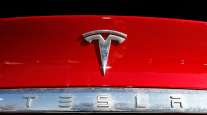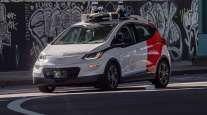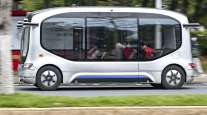Waymo CEO Krafcik Has ‘A Lot of Confidence’ His Tech Would Have Avoided Deadly Uber Accident

In a pioneering self-driving car company’s first public comments on the Uber autonomous car accident March 18 that killed an Arizona woman, Waymo CEO John Krafcik said his tech could “handle” that very scenario.
“I want to be really respectful of Elaine, the woman who lost her life, and her family,” Krafcik said at a National Automobile Dealers Association meeting in Las Vegas March 24. “(But) in the case of a pedestrian or a pedestrian with a bicycle, we have a lot of confidence that our technology would be robust and would be able to handle situations like that one.”
Krafcik did not comment on the status of Waymo’s self-driving car passenger pick-up program that has been going on for more than a year in the Phoenix area, which suggests Waymo will not pause its self-driving car testing.
RELATED: Regulators are asleep at the wheel on self-driving cars
Toyota and nuTonomy said they were pausing their testing on public roads, but so far, they remain the only companies other than Uber to halt such tests.
The accident, which has sent a shudder through the self-driving car community, involved an Uber self-driving Volvo that was driving through Tempe, Ariz., on the night of March 18.
Elaine Herzberg, 49, was walking her bicycle across a multi-lane thoroughfare as the Uber car in autonomous mode — with safety driver Rafaela Vasquez, 44, in the driver’s seat — collided with her at approximately 40 miles per hour. Herzberg died of her injuries at the hospital. Tempe police and federal investigators are both looking into the accident.
RELATED: Uber crash is nightmare driverless world feared but expected
Some self-driving car experts have suggested that the sensors on the Uber car — in particular radar and a laser-radar system called LiDAR, which stands for light detection and ranging — failed. Radar and LiDAR are designed specifically to track objects and people at a great distance and slow or stop the car if a collision is imminent.
“This type of scenario is exactly what (autonomous vehicles) are built to handle, seeing an obstacle far ahead and if necessary stopping,” Raj Rajkumar, the head of autonomous vehicle research at Carnegie Mellon University, told USA Today. “All groups working in this space likely are having intensive meetings now, trying to find out what happened with the Uber system, and if they may have the same issue.”
LiDAR an issue between Waymo, Uber
Last year, Waymo sued Uber, saying the ride-hailing company had developed LiDAR for its cars using trade secrets acquired when Uber purchased Otto, a self-driving truck company founded by former Google engineer Anthony Levandowski.
After a week in court, the case was settled with Uber agreeing to give Waymo $245 million in equity and to have its tech development monitored for any trade secret use. Uber never admitted any guilt in the matter and had always maintained that its LiDAR was developed in-house by its engineers.
Waymo said in a statement that its long-range LiDAR, which it spent “years developing and customizing,” allows its self-driving cars to identify objects up more than 300 yards away in all directions.
“The detail we capture with our custom LiDAR is so high that not only can we detect pedestrians all around us, but we can tell which direction they’re facing,” Waymo said.
In his comments March 24, Krafcik — who leads a company that started working on autonomous cars back in 2009 — said the Uber incident was a devastating moment not only because it resulted in a woman’s death, but also because it represents a failure of technology at a critical juncture in its development. Many polls show that people remain unsure of the safety of autonomous tech.
RELATED: Uber death elicits warning from Teamsters wary of robo-truckers
“For those of us at Waymo, it was a very sad day, because that was an accident that was in a car that had technology representing the self-driving space,” he said. “(For Waymo), it is the mission of safety and avoiding accidents just like that one that brings us all together as a company. So, it struck us, I think, in a very, very, very major way.
“We’ve now driven on public roads for more than 5 million miles. We’ve put together this amazing testing program, which includes those public roads, and we do a lot of work in simulation, 5 billion miles in computer simulation, testing our software and our sensing,” he said. “We’ve developed tens of thousands of actual physical tests that really put our technology through its paces and ensure that it’s strong and capable and of course very, very safe.”
Waymo has a dedicated and private testing facility in California where it first tests new self-driving car software and runs through potentially dangerous scenarios — such as a car suddenly backing out of its driveway — before taking cars on the open road.
USA Today visited the facility, and rode in self-driving cars without safety operators as the vehicles did loops around what amounts to a fake city. What the facility does not offer, however, is inclement weather, which is considered a bit of an obstacle for self-driving tech. Waymo and other companies also are starting to test in Michigan as a result.
Waymo recently announced that it was ready to allow its self-driving cars to pick up passengers in its Phoenix-area testing program without any safety operator in the driver’s seat.
After the accident, it remains to be seen if Waymo goes through with that change and whether it will still make its self-driving cars available to all consumers in Phoenix later this year as planned.
Distributed by Tribune Content Agency, LLC





